Marble runs are more than just captivating toys; they’re miniature physics labs that bring the laws of motion and energy to life. Every twist, turn, and drop is a symphony of scientific principles, from gravity’s relentless pull to the exciting dance between potential and kinetic energy.
In this article, we’ll explore the fascinating physics of marble runs and the forces and interactions that create the mesmerizing movement and captivating chaos of rolling spheres. Get ready to discover how a simple toy can reveal the hidden wonders of the physical world.
Gravity
Gravity, the unseen conductor of the marble-run orchestra, is the essential force that brings the magic to life. The invisible hand pulls each marble down the track, determining its speed, trajectory, and, ultimately, its performance in the race.
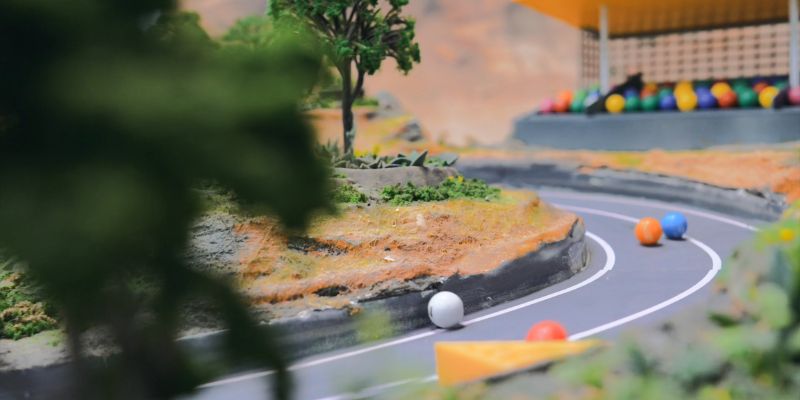
The Science Behind the Roll
Newton’s Law of Universal Gravitation explains that every object in the universe attracts every other object with a force that is directly proportional to their masses and inversely proportional to the square of the distance between their centers. In simpler terms, the closer and more massive the objects, the stronger the gravitational pull.
In marble runs, the Earth exerts a downward force on each marble, pulling it toward the ground. When you place a marble at the top of a ramp, gravity becomes the driving force, compelling the marble to roll downwards.
Acceleration
As the marble descends the ramp, gravity sets it in motion and accelerates it, causing it to move faster and faster. The steeper the ramp, the greater the gravitational pull and acceleration. This explains why marbles zoom down steep slopes and move more slowly on gentler inclines.
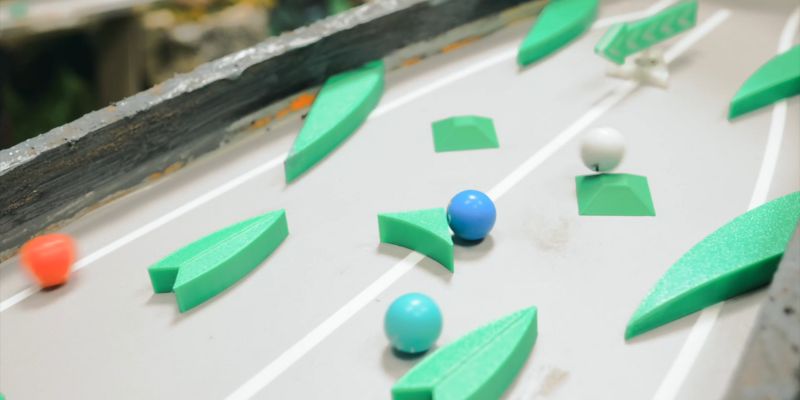
Freefall
One of the most thrilling aspects of marble runs is witnessing gravity in its purest form: freefall. This occurs when a marble drops vertically without any track or surface to guide it. In freefall, the marble experiences the full force of gravity, accelerating at a constant rate until it reaches its terminal velocity, the maximum speed it can achieve due to air resistance.
Banking on Turns
Even on curved sections of the track, gravity plays a crucial role. It helps the marble maintain speed by pulling it toward the center of the curve. Many marble runs feature banked turns, where the outer edge is higher than the inner edge. Banking helps the marble stay on track and prevents it from flying off at high speeds.
Experimenting with Gravity
You can explore the effects of gravity on your marble run by experimenting with different ramp angles, heights, and materials. Notice how steeper ramps lead to faster speeds and how heavier marbles are less affected by friction. Creating a freefall section can also dramatically demonstrate gravity in action.
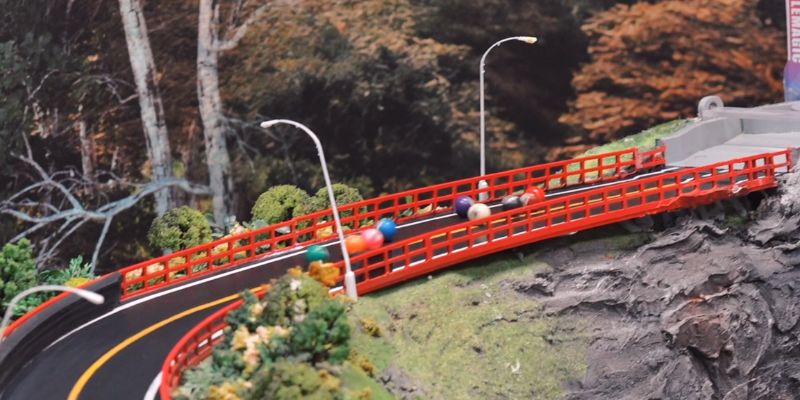
By understanding the role of gravity in marble runs, you can harness its power to create thrilling races and exciting challenges. Let gravity be your guide as you design and build your next marble run masterpiece!
Energy Transformation
The exhilarating twists, turns, and drops of a marble run highlight the interplay between potential and kinetic energy as the marbles navigate the course.
Understanding the Energy Duo
Potential Energy (PE): Picture a marble perched at the top of a ramp, brimming with stored energy due to its elevated position. This is gravitational potential energy. The higher the marble, the greater its potential energy, poised to be released as soon as it starts moving.
Kinetic Energy (KE): Once the marble is in motion, its potential energy transforms into kinetic energy, the energy of movement. The faster the marble rolls, the more kinetic energy it accumulates, enabling it to navigate the track, overcome obstacles, and race toward the finish line.
The Energy Dance in Action
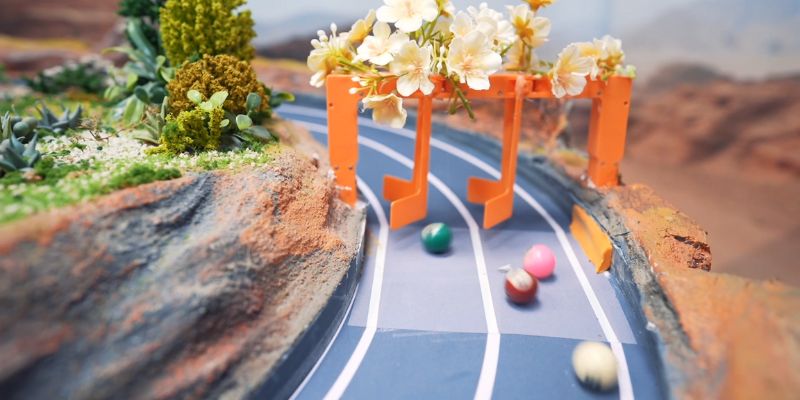
As the marble travels through the track, it undergoes a continuous transformation of energy
- The Peak of Potential: At the starting point, usually the highest point of the track, the marble holds maximum potential energy while its kinetic energy is zero, as it’s yet to begin moving.
- The Descent: As the marble rolls down, its potential energy diminishes while kinetic energy builds up. The steeper the slope, the quicker this energy transformation occurs.
- The Loop-de-Loop: At the top of a loop, the marble’s potential energy reaches a low point while its kinetic energy peaks, allowing it to defy gravity and complete the loop successfully.
The Final Stretch: Approaching the finish line, the marble’s potential energy continues to drop as it loses height, but depending on the track design, it can still retain significant kinetic energy, crossing the finish line at impressive speeds.
Conservation of Energy
Throughout the marble’s journey, the total energy (potential plus kinetic) remains constant, illustrating the law of conservation of energy, a fundamental principle in physics.
Friction
Friction is both an unsung hero and an occasional villain, significantly impacting each race’s outcome. This force, which resists motion between surfaces, might seem straightforward, but it has profound effects on how marbles behave on the track. Let’s explore the fascinating dynamics of friction and its influence on marble racing.
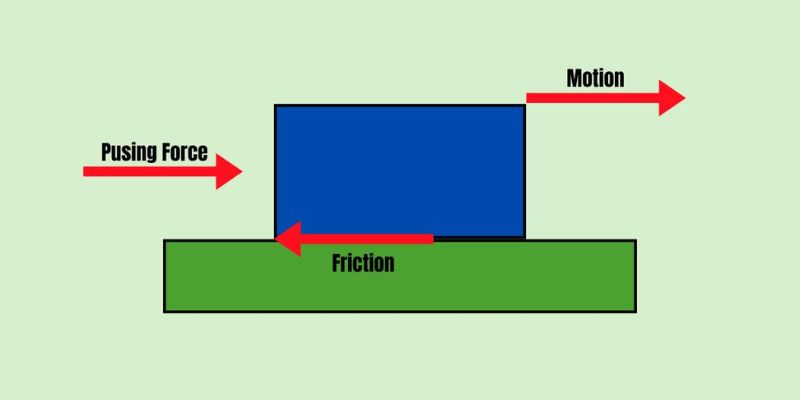
Friction is the force that opposes motion between two contacting surfaces. In a marble run, this means the friction between the marble’s surface and the track. The greater the friction, the more resistance the marble encounters, leading to slower speeds.
Types of Friction
- Static Friction: This initial resistance prevents a stationary marble from starting to move. Overcoming this force is the first step to getting your marble rolling.
- Kinetic (or Sliding) Friction: Kinetic friction takes over once the marble is in motion. This force continuously opposes the marble’s movement, gradually slowing it down.
Factors Influencing Friction
Several elements affect friction in marble racing:
- Surface Material: Smooth materials like plastic or polished wood offer minimal friction, enabling faster speeds. Rougher materials like sandpaper, unfinished wood, or fabric increase friction, slowing the marbles down.
- Marble Material: The marble’s material also influences friction. Glass marbles are smoother and experience less friction than rougher stone or unfinished wood marbles.
- Contact Area: The larger the contact area between the marble and the track, the greater the friction. Larger marbles or those with broader contact patches face more resistance than smaller, narrower marbles.
- Temperature and Humidity: Environmental factors also play a role. Warmer temperatures can slightly reduce friction, while humidity can increase it by creating a thin layer of moisture on the track.
Friction as a Design Tool
Friction isn’t merely an obstacle to overcome; it’s a strategic element that can be used to enhance your track design.
- Controlling Speed: By strategically placing high-friction materials, like sandpaper patches or rougher track sections, you can create “braking zones” that slow down marbles and introduce an element of strategy to the race.
- Creating Challenges: Obstacles such as uphill sections or rough terrain that increase friction can test the marbles’ ability to maintain momentum and add more difficulty to the race.
- Adding Realism: Incorporating friction makes the marble run experience more realistic and engaging, mirroring real-world physics.
By understanding the nuances of friction and how to manipulate it, you can design marble racing tracks that are not only fast and thrilling but also offer a variety of challenges and strategic opportunities. Whether aiming for breakneck speeds or intricate obstacle courses, mastering friction is key to creating the ultimate marble racing experience.
Momentum
In the thrilling world of marble racing, momentum is the secret ingredient that distinguishes champions from contenders. It’s the force that propels marbles forward, helping them conquer challenging obstacles, maintain speed on straightaways, and, ultimately, clinch victory. Let’s explore how momentum influences every roll, turn, and jump in a marble race.
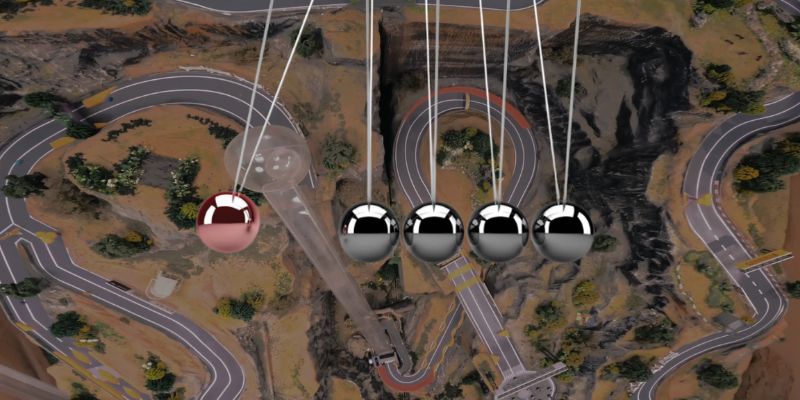
Unleashing the Power of Momentum
In its simplest form, Momentum is the “oomph” behind a moving object. In physics, it’s defined as the product of an object’s mass and velocity. This means a heavier marble moving at a certain speed will have more momentum than a lighter marble at the same speed.
In marble racing, this translates to several key advantages
- Maintaining Speed: Marbles with higher momentum can keep their velocity over longer distances, even with slight inclines or obstacles. This explains why heavier marbles, like those made of steel, often outperform lighter ones on longer tracks.
- Overcoming Obstacles: Momentum is crucial for conquering loops, jumps, and uphill sections. A marble with enough momentum can even complete a full 360-degree loop. Imagine a steel marble gaining speed on a long ramp and then effortlessly soaring through a loop – that’s the power of momentum in action.
- Collisions: When marbles collide, the one with more significant momentum usually prevails, pushing aside lighter or slower marbles and significantly altering the race’s outcome. It’s similar to billiards, where a well-aimed cue ball can scatter other balls.
- Drafting: In racing, drafting involves following closely behind a leading competitor to reduce air resistance and gain speed. Marble racers can use this strategy, trailing a faster marble to gain a boost before attempting an overtake.
Strategic Momentum Management
Understanding momentum is just the beginning. To excel in marble racing, you need to harness and manipulate this force to your advantage
- Choosing the Right Marble: Consider the track layout and select a marble with the right mass and potential velocity combination. A heavier marble might excel on a track with many obstacles, while a lighter one might perform better on a tight-turn track.
- Track Design: Design your track with momentum in mind. Incorporate slopes, curves, and banked turns that allow marbles to build and maintain speed. Avoid sharp turns or sudden elevation changes that can cause marbles to lose momentum.
- Starting Strategy: A strong start is crucial for building early momentum. Practice your release technique to ensure your marble gets a good initial push.
- Obstacle Management: Anticipate how obstacles will affect your marble’s momentum. Use ramps to build speed before jumps, and navigate curves smoothly to avoid losing momentum.
By understanding and applying the principles of momentum, you can elevate your marble racing from a simple pastime to a strategic and exhilarating sport. So, let’s get those marbles rolling and experience the power of momentum in action!
Air Resistance: The Unseen Force
While gravity is the undeniable force propelling marbles down the track, air resistance is another subtle yet significant factor that influences every race. Often overlooked, this invisible opponent can greatly impact a marble’s speed and trajectory, especially at high velocities. Let’s delve into the mysteries of air resistance and understand its effect on marble racing.
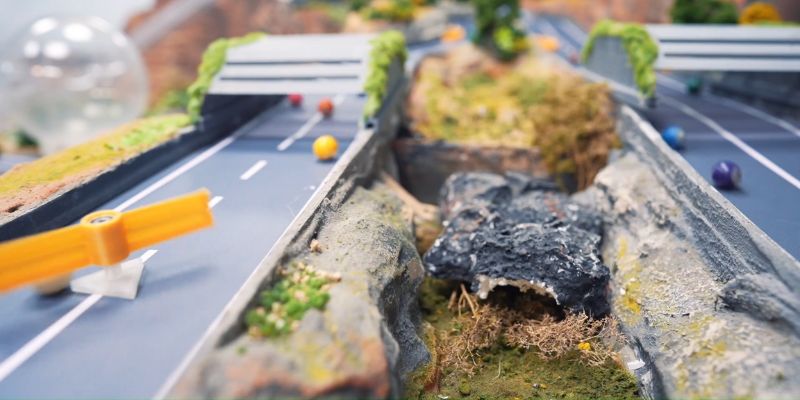
The Science of Air Resistance
Air resistance, or drag, is the force that opposes an object’s motion through the air. As a marble races down the track, it collides with air molecules, creating resistance that slows it down. The faster the marble moves, the greater the air resistance it encounters.
Factors Affecting Air Resistance
Several factors influence the amount of air resistance a marble faces:
- Speed: The faster a marble travels, the more air molecules it encounters, increasing air resistance.
- Shape: A marble’s shape determines how easily it cuts through the air. Streamlined shapes like spheres or teardrops experience less air resistance than less aerodynamic shapes, such as cubes or pyramids.
- Surface Area: A larger surface area means more collisions with air molecules, leading to more excellent air resistance.
- Air Density: Denser air creates more resistance. This is why marbles roll faster at higher altitudes, where the air is thinner.
Minimizing Air Resistance: Strategies for Speed
To maximize speed on a marble run, minimizing air resistance is key. Here are some strategies
- Streamlined Shapes: Choose marbles with aerodynamic shapes like spheres or teardrops. Avoid marbles with rough or irregular surfaces, which create turbulence and increase drag.
- Reduce Surface Area: Smaller marbles generally experience less air resistance than larger ones. However, consider the track’s design and obstacles, as smaller marbles might get stuck or lose momentum more efficiently.
- Track Design: Build tracks with smooth transitions and minimal obstacles that could disrupt the airflow around the marble. Avoid sharp turns or sudden drops that can cause the marble to tumble and increase air resistance.
- Material Choice: To reduce resistance and maximize speed, use materials with low surface friction, such as plastic or polished wood.
The Impact on Racing
Air resistance may seem minor, but it can significantly impact marble racing outcomes, particularly in longer races or on high-speed tracks. Marbles with less aerodynamic shapes or larger surface areas will experience more drag, slowing them down and affecting their final position in the race.
Understanding air resistance is crucial for both track designers and racers. Designers can create tracks that minimize air resistance and allow marbles to reach their full potential, while racers can choose marbles and develop strategies that take advantage of aerodynamic principles. By mastering the art of minimizing air resistance, you can unlock a new level of speed and excitement in your marble racing adventures.
Collisions: A Clash of Marbles
In the dynamic world of marble racing, collisions are an electrifying element that can turn a predictable race into a heart-stopping spectacle. These marble-on-marble clashes are a battle of momentum, a test of resilience, and a source of endless drama for racers and spectators. Let’s dive into the physics and excitement behind these collisions
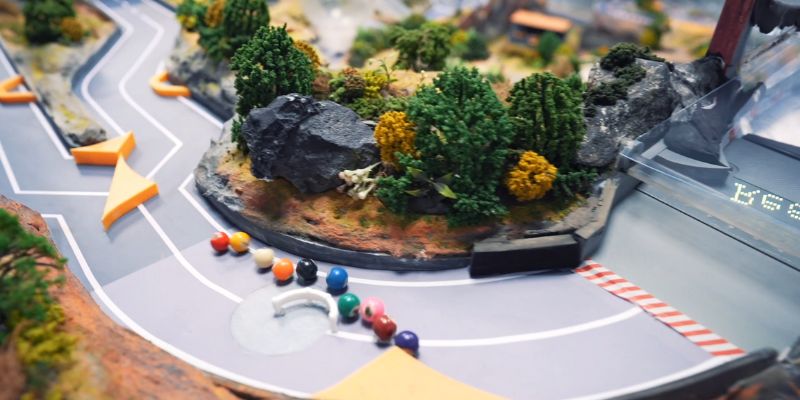
The Science of Impact
A collision in marble racing is a transfer of energy and momentum between marbles. When marbles collide, their kinetic energy—the energy of motion—is redistributed, resulting in changes in direction, speed, or even a complete stop.
- Elastic Collisions: In a perfectly elastic collision, the total kinetic energy of the system is conserved. Marbles bounce off each other without any loss of energy, similar to billiard balls on a pool table.
- Inelastic Collisions: More common in marble racing, these collisions involve kinetic energy converted into heat or sound as the marbles absorb some of the impact.
Factors Influencing Collisions
The outcome of a collision depends on several factors:
- Momentum: The marble with greater momentum—mass times velocity—will substantially influence the crash, often pushing other marbles off course or significantly altering their trajectories.
- The angle of Impact: The angle at which marbles collide can drastically affect the result. A head-on collision causes the marbles to rebound in opposite directions, while a glancing blow might only slightly alter their courses.
- Track Material: The surface of the track also plays a role. Smoother surfaces result in more elastic collisions, whereas rougher surfaces cause more energy loss in the impact.
Collisions and Strategy
Collisions aren’t just random events; skilled racers can strategically utilize them.
- Offensive Collisions: Some racers intentionally use collisions to their advantage, bumping opponents off course or slowing them down. This tactic is risky as it can backfire and cause the aggressor to lose momentum.
- Defensive Collisions: Racers can position their marble to block or deflect an opponent’s attack, using collisions to maintain their lead.
- Chain Reactions: A single collision can trigger a chain reaction, causing multiple marbles to collide and potentially altering the entire course of the race.

















